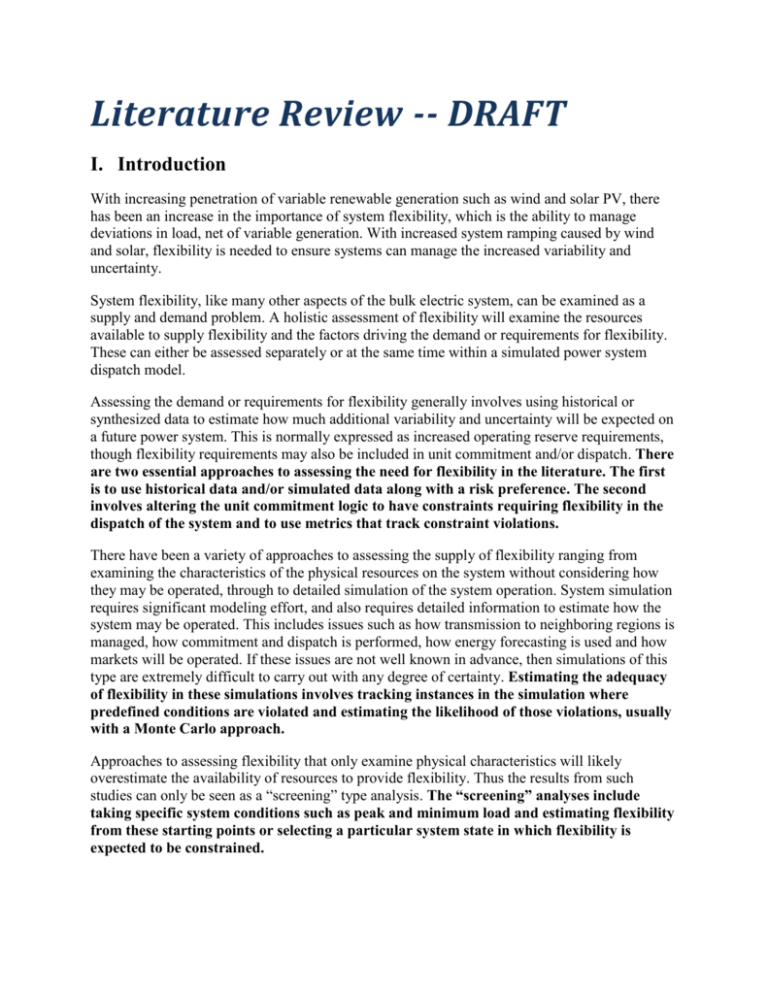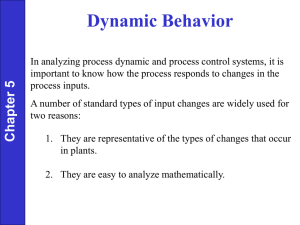Literature - Northwest Power & Conservation Council
advertisement

Literature Review -- DRAFT I. Introduction With increasing penetration of variable renewable generation such as wind and solar PV, there has been an increase in the importance of system flexibility, which is the ability to manage deviations in load, net of variable generation. With increased system ramping caused by wind and solar, flexibility is needed to ensure systems can manage the increased variability and uncertainty. System flexibility, like many other aspects of the bulk electric system, can be examined as a supply and demand problem. A holistic assessment of flexibility will examine the resources available to supply flexibility and the factors driving the demand or requirements for flexibility. These can either be assessed separately or at the same time within a simulated power system dispatch model. Assessing the demand or requirements for flexibility generally involves using historical or synthesized data to estimate how much additional variability and uncertainty will be expected on a future power system. This is normally expressed as increased operating reserve requirements, though flexibility requirements may also be included in unit commitment and/or dispatch. There are two essential approaches to assessing the need for flexibility in the literature. The first is to use historical data and/or simulated data along with a risk preference. The second involves altering the unit commitment logic to have constraints requiring flexibility in the dispatch of the system and to use metrics that track constraint violations. There have been a variety of approaches to assessing the supply of flexibility ranging from examining the characteristics of the physical resources on the system without considering how they may be operated, through to detailed simulation of the system operation. System simulation requires significant modeling effort, and also requires detailed information to estimate how the system may be operated. This includes issues such as how transmission to neighboring regions is managed, how commitment and dispatch is performed, how energy forecasting is used and how markets will be operated. If these issues are not well known in advance, then simulations of this type are extremely difficult to carry out with any degree of certainty. Estimating the adequacy of flexibility in these simulations involves tracking instances in the simulation where predefined conditions are violated and estimating the likelihood of those violations, usually with a Monte Carlo approach. Approaches to assessing flexibility that only examine physical characteristics will likely overestimate the availability of resources to provide flexibility. Thus the results from such studies can only be seen as a “screening” type analysis. The “screening” analyses include taking specific system conditions such as peak and minimum load and estimating flexibility from these starting points or selecting a particular system state in which flexibility is expected to be constrained. There are four methods that fall between a full system simulation and “screening”. They involve: 1) assessing the maximum system ramping capability using an approach such as Cumulative Ramp Duration Curves (CRDC), 2) examining a system committed strictly for economic dispatch and measuring the periods where the system is short of flexibility, 3) adding states estimates, e.g. online or forced out, to generating units that supply flexibility to the system, and 4) adding generation characteristics such as must-run and committing or de-committing all units and estimating the ramping characteristics. Note some combination of these could also be used and there may be additional methods possible which fall in between these four main categories. II. Flexibility Requirements There is a large range of literature assessing flexibility requirements. These generally take the form of assessing the incremental reserve requirements to manage wind and/or solar PV. The most significant methods are reviewed here at a high level. More detailed reviews of these requirements for operating reserve imposed by variable generation are given in other papers, e.g. [NREL11a]. A. Operating Reserve Requirements In the academic literature, there are a number of notable papers on reserve requirements. With increased penetrations of variable generation, the variability and uncertainty on different time scales need to be adequately covered. A relatively basic method to do this is to assess historical data and determine the standard deviation of the time series. Expressing this as a confidence interval that covers a certain number of standard deviations allows for reserves to be carried according to risk preference (e.g. 99.7% of variation in a Gaussian distribution for three standard deviations). Doherty and O’Malley propose a method which calculates reserve requirements by combining the requirements due to wind and load forecast error and holding a constant probability of a load shedding event for each hour as reliability criteria [Doherty05]. Da Silva et al examine the amounts of static and operating (spin and non-spin) reserves required to maintain reliability with increased penetrations of variable generation [daSilva10]. Here, longterm planning metrics are augmented with a new set of metrics relating to operating reserves. Monte-Carlo simulation is used to determine these performance indices with variable generation represented by sampling from historical wind power data based on wind speed and power conversion characteristics. This probabilistic approach ensures sufficient reserves of the right type are carried, and planning margins are sufficient. Bouffard explores adapting the classical unit commitment problem to account for operational flexibility requirements [Bouffard11]. This is included in an additional inequality added to classical UC problem, where it is compared to the flexible capacity available. The former is calculated based on current commitment and expected dispatch (accounting for offline resources which can come online). This method allows for different flexible response times to be examined, and could potentially be used with more simplistic data outside the UC problem. As well as the above academic papers, there are a number of studies which talk about the increased reserve requirements. These generally analyze historical data, or data synthesized to determine what wind and/or solar output may look like for a given location in the future based on weather patterns from a past year or years. The most relevant of these are efforts from the National Renewable Energy Laboratory (NREL), which have evolved over the past few years. A good summary from 2010 is provided in [NREL11b]; the methods have been updated since but use much the same concepts. As part of both the Eastern and Western Wind and Solar Integration Studies, NREL and its contractors have prepared series of reserve requirements which will be required to manage the variability of demand and net load in the regulation and intra hour time frame. These reserve requirements are the basis for the system flexibility requirement. The regulation and flexibility reserves are based on the standard deviation of demand, wind and solar variability over time scales of 10 and 60 minutes respectively. The variability of wind and load is measured as the absolute change in load or wind generation over a given time period of interest. For solar generation, the variability is measured with respect to the clear sky output of the solar generators at any given time [Ibanez 2013]. The reserve requirements are set to meet a user determined range of variability. Using the reserve requirement in each net load interval, the amount of reserve at any net load level can then be deduced. The most recent example showing the latest iteration of this NREL method was for phase 2 of the Western Wind and Solar Integration Study [NREL 2013]. Other methods have also been proposed in the various wind and solar integration studies. Another notable example was proposed in [PNNL2012]. The joint effort between Pacific Northwest National Laboratory (PNNL), the California Independent System Operator (CAISO) and Areva lead to the development of a ramping requirement indicator for use with the Energy Management System in California. The proposed method is a determination of regulation, load following and ramping requirements based on historical and forecast data. Using the "swinging door" methodology, time series are broken down into specific ramps with individual ramping, capacity and regulation measurements. The joint probability of meeting these three measurements is then used to estimate reserve requirements. The North American Electric Reliability Corporation (NERC) Integration of Variable Generation Task Force established a number of task forces to address some concerns arising from the initial analysis completed by the NERC group. Task force 1.4 was established to examine the requirements for flexibility and flexibility metrics [NERC10]. Based on experiences from areas with high penetrations of variable renewables, the group concluded that the main characteristics to include when measuring flexibility include ramp magnitudes, response rates, ramp frequency and ramp intensity. The group proposed a method to characterize the flexibility of a system based on these four characteristics. This was one of the first documents to address the issue of power system flexibility explicitly. The flexibility assessment methods proposed were not demonstrated, but a framework to structure a possible assessment was outlined. The main outcome was a measurement of flexibility requirements as defined by the ramp intensity metric. The ramp intensity was defined as the product of the magnitude and ramp rate of a given ramp. The ramps were categorized based on the time scale and frequency of occurrence. III. Assessing available flexibility and flexibility adequacy There are a number of methods to assess available flexibility on the system. As described above, these fit on a spectrum from analyzing purely the physical characteristics of all resources on the system, to estimating how much flexibility is available based on detailed simulation of future years, or examining historical data. Here, this is split into three main areas – a screening level, an intermediate level and a detailed simulation level. Note that in some of these methods, there is also an assessment of the variability required. In putting a method into practice, there may be an opportunity to use the flexibility availability assessment described here with a different method described in the previous section to determine flexibility requirements. B. Screening Available Flexibility Screening the available flexibility in a system means assessing the resources based purely on their physical characteristics, without assessing how they may operate. The purpose here is to determine what the capability to ramp is for a set of resources. The International Energy Agency, in the Flexibility Assessment Tool (FAST) version 1 provides a good example of this [IEA11]. This is a Microsoft Excel based spreadsheet examining flexibility resources available. The dispatch at peak and minimum load is estimated based on generator characteristics and user knowledge. The available flexibility from resources is then quantified on different time horizons of interest (15 minutes, 1 hour, 4 hours and 12 hours) for up and down ramping. This is then extrapolated to determine the maximum variability which could be met by the resources on the system. Assumptions are made for flexibility from interconnection to neighboring regions, demand response and storage which are optimistic in nature. The variability of load, wind and PV is assumed uncorrelated and worst case variability which can occur is therefore assessed. This may mean being overly conservative in the real amount of variability which can be met, while the assumptions leading to a final "penetration level possible" may be too optimistic in disregarding the reality of the likely dispatches which could be seen. Some components of the tool could be used to provide qualitative assessment on the resources available and the positive and negative factors affecting a particular system's flexibility, but the overall results are likely to be very high level and may not be very accurate given the range of assumptions. Another screening type approach is used in Portland General Electric’s (PGE’s) 2012 Integrated Resource Plan. Adopted from Northwest Power and Conservation Council (NWPCC) paper discussed in the next subsection, this takes what appears to be a simpler approach than that paper. For each of the relevant time scales up to one hour, it quantifies the required flexibility and then the available flexible resource. The available resource is quantified by 'turning on' all resources and moving them up to maximum capacity as soon as possible (for down ramp, only hydro resources are examined). The study compares the amount of available capacity estimated in this way with the variability required and determines whether there is sufficient flexibility. The amount required is examined for different percentiles. Forced outages and regulation requirements are not accounted for. Different quarters are examined as Q2 is not expected to have as much flexibility available. The study shows PGE meeting up ramp requirements in 2015 but not 2020 and not meeting down requirements in either 2015 or 2020, though these can be managed through curtailment and are economical in nature. A final screening type approach is found in a paper from Ma and Kirschen [Ma, 2013]. The flexibility of conventional generation resources is dependent on their ramp rate, operating range and start up time. In this paper the authors present a flexibility index for a system's generation resources both individually and aggregated on a system-wide basis. The method does not consider the requirements for flexibility due to ramping or contingency events, rather it is a means to measure the flexibility of the resources. A further limitation of this methodology is that it does not consider the limitations on the availability of flexibility of hydro and other energy limited resources. C. Intermediate Assessment Intermediate assessment methods are defined here as methods which take a more detailed approach than those in the previous subsection, but still do not examine a full commitment and dispatch study, with all of the associated modeling implications and challenges. The first example is from Schilmoeller [NWPCC12]. This paper quantifies the requirement for and provision of imbalance reserves. The supply of imbalance resources is quantified using an approach that allows for ordering of the resources available over different time scales such that varying speeds of response can be combined to give overall system ramping available. This shows the total ramping that can be provided over a certain amount of time. The method then computes imbalance reserve requirements, describing first a cumulative ramp duration curve, which doesn't account for recovery of capacity. The ability of capacity to recover over the course of a net deployment is then described considering the initial conditions, referred to as a path. The total requirements are then computed as the minimum resource required meeting all of the paths. Comparing the requirements to the capacity available shows whether and how the system does not have sufficient flexibility. This was simplified for the approach used by PGE described above. The International Energy Agency improved upon the FAST tool in a subsequent study to that described above [IEA13]. Using basic assumptions about a dispatch stack of the resources in a given area, the FAST v2 method determines the limits on the availability of flexibility based on optimistic (flexible) and pessimistic (inflexible) assumptions about how a power system is operated. The system is dispatched using the two different perspectives on dispatch over the course of a time series (e.g. 1 year). The optimistic dispatch commits excessive capacity to meet net demand, resulting in generation being operated close to minimum generation levels in order to maximize upward maneuverability to meet upward ramps. The pessimistic dispatch operates the system in a way which does not take into account the ramping, start-up and minimum up or down times of units, but based on plant economic characteristics only. The result of the pessimistic approach is a dispatch which is inherently short on upwards flexibility. In order to assess downward flexibility, the roles of each dispatch perspectives are reversed. Based on the dispatches, the availability of flexibility from the system's resources can be determined, and the number of periods when a system is potentially short of flexibility can be calculated for a variety of time horizons. This is an intermediate level approach which, while requiring extensive data, is not computationally intensive. These types of methods are useful in assessing flexibility at the outset of long-term planning studies to understand the approximate limits and requirements for system operation. An alternative, but similar, method which is comparable to the IEA FAST v2 methodology is to determine the flexibility of the system using a dispatch stack methodology to determine the state of a system's generation resources over the course of a year, as described in Lannoye et al [Lannoye12a]. Using these states (offline, online, dispatch level), the flexibility from generation units can be determined over a course of a year over a variety of time horizons (e.g. 5 minutes, 1 hour, 3 hours). This approach allows significant numbers of scenarios to be assessed quickly while capturing some, but not all, of the likely operational limits of a system. The amount of available flexibility is then compared to the net load ramping requirements at each coincident interval in time as well as the requirement for contingency reserve. Using that comparison, a variety of metrics can be calculated to measure the frequency and magnitude of potential flexibility deficiencies. A final intermediate approach is given by the Electric Power Research Institute (EPRI), [EPRI13]. The methods in this report describe levels 1 and 2 of the EPRI flexibility assessment tool, Inflexion1. This assesses variability of the system net load based on time series data (one year at 5 minute intervals preferred). A number of analyses are performed over a range of time scales, allowing various metrics to be quantified and graphs produced for flexibility requirements. The flexibility requirements can be adjusted in many ways to reflect many of the requirements methods. In level 2, the flexibility available is quantified using characteristics such as ramp rate, start time and minimum generation, together with whether a generator is must run or not. The available flexibility is quantified in terms of system ramp rate assuming all units are either online or all are offline, which gives upper and lower bounds in terms of how much flexibility is available from a standing start versus how much is available if all are online. The minimum generation level is determined based on providing information about which generators are likely to be kept online if possible. This is then used to estimate potential curtailment due to lack of down ramping capability. The up ramping capability is compared in a similar fashion to the PGE method. To obtain accurate results on flexibility available, significant details about likely commitment status are needed. These levels do not calculate a dispatch and this can only be used to estimate flexibility provision, but metrics and graphs produced do allow for comparison of how different resources provide flexibility. Time of day and month of year are also examined to determine when flexibility requirements are highest. D. Detailed Assessment Methods The final set of approaches requires more detail on system operations, generally meaning a full unit commitment and economic dispatch is required. New metrics and techniques have evolved to use existing or adopted production simulation tools to assess flexibility. The insufficient ramping resource expectation (IRRE) metric is a probabilistic method of assessing the frequency of flexibility deficits [Lannoye12b]. This metric is dependent on the outcome of production cost modeling which determines the dispatch level of each resource over the course of a study period. Based on the dispatch level, resource parameters and availability, a distribution of flexibility available in the system can be determined. This can be then used to determine the probability of meeting net load ramping events throughout the course of the year. When those probabilities are aggregated into an expected value, the result is a metric for the overall flexibility of the system. This metric can be applied to ramping in the upward and downwards directions and for a range of time horizons, so that distinct flexibility issues can be identified. EPRI extended the IRRE approach [EPR13], and four metrics are calculated using results from either a production simulation model or historical dispatches. Using generator characteristics as in the EPRI Screening methods, and the time series of flexibility requirements, these metrics assess flexibility adequacy. Insufficient Ramp Resource Expectation is as described in Lannoye EPRI’s Inflexion tool is currently only available to funders of the EPRI project “Strategic and Flexible Planning”. However, BPA is a member and the relevant parts of that tool could be made available if of interest to this group. 1 (2012) above. Probability of Flexibility Deficit and Expected Unserved Ramping are, respectively, measures of the likelihood and total magnitude over one year of flexibility deficiencies. These are calculated by comparing a time series of available flexibility with requirements based on the load, wind and PV for each particular hour (i.e. if a given hour has low load and high wind, the more extreme ramps are likely to be increases in net load and vice versa). Percentiles can also be used to calculate the requirements, which are assessed over different times scales and for up and down ramping. The fourth metric is a well-being analysis based on the combination of magnitude and frequency; users determine comfort levels (e.g. allow for x MWh and y% likelihood but warn at higher levels), and the results are graphically displayed. These metrics have been tested using case studies but, other than IRRE, not on a real system. The REFLEX tool developed and implemented by E3 consulting, can be characterized as a detailed Monte-Carlo simulation of a system under a wide range of system operating conditions [E313]. Using a similar concept to the SERVM tool to draw Monte-Carlo scenarios of demand and variable generation, the availability and generation levels of flexible resources are determined using conventional scheduling tools, such as Energy Exemplar's Plexos tool. A significant number of short, three day scenarios are simulated and the resulting energy and reserve violations are aggregated and assessed. The impacts of these violations are characterized by a set of proposed metrics which measure the frequency and magnitude of flexibility shortages for both upward and downward flexibility. It is also possible to deduce from these results, the cause of the flexibility violation (e.g. ramp rate limits, operating range limits, minimum up time limits etc.). In order to calculate these detailed metrics, a considerable amount of data is required for the production cost simulation and to create the distributions of demand and variable generation. Additionally, since the generation dispatches are determined using standard production cost tools, the computational burden can be significant. However, the nature of the simulation means that the outcome of different scenarios can be computed in parallel, reducing the overall run time. This method has been implemented on the Californian system to examine the flexibility of the system under future high variable generation scenarios. Menemenlis et al. [Mene11] propose a method of assessing flexibility based on definitions from the domain of process control and design. The paper is focused on determining the effect which operational processes have on the deliverability of the flexibility available from generators as opposed to identifying the technical capability of a system’s resources. The underlying flexibility metric is based on simulating a wide variety of probability weighted scenarios, and then determining the balancing reserve required to meet these scenarios based on certain defined variables such as ramp rate of the system and demand. Based on user defined reliability or economics limits for each of those variables, the size of the balancing reserves can be reduced to reflect the user risk preferences. The ratio of the volume of reduced requirements to the volume of the original requirement is an indication of the system flexibility. This methodology could be used in both an operational and planning context, but is computationally and data intensive. Therefore, this method is more suited to real-time, or near real-time operations, rather than planning applications. A final detailed method to assess flexibility is proposed in [Studarus13]. This metric is designed specifically for hydro systems. Taking into account the range of constraints on a hydro system, it shows how much flexibility is operationally available as a time series. The focus is on short term hydro scheduling, and compares a deterministic representation of the flexibility available from the system based on confidence intervals with a deterministic representation of the inherently stochastic flexibility requirements. The main purposes are as a visualization tool for operators and for short term optimization. Comparing existing requirements (INC and DEC) with constraints on available resources, the lack of upwards or downwards flexibility can be quantified. This assumed that operations remain the same in the future, similar to many other methods, and aspects such as shorter dispatch interval do not occur. It can be used to visualize, for example, over the next 4 hours, 24 hours and 7 days, and compare to forecasts of what will be required, to determine whether there is sufficient flexibility. This could feasibly be used with planning data to assess adequacy. The main contribution of this method is to determine flexibility available from hydro generation, while providing a detailed look at whether this implies enough operational flexibility available. While some of the methodologies proposed are for the exclusive assessment measurement of flexibility, other proposals adapt existing reliability assessment approaches to incorporate system flexibility limits. An example is given by EPRI’s use of the SERVM reliability assessment and production simulation tool [EPRI13]. Using production cost simulation tools, which relax certain constraints in return for reduced computational time, the loss of load probability can be calculated using Monte-Carlo type draws of demand and variable generation production data. By including ramping, and other temporal constraints in production cost simulation tools such as ASTRAPE's SERVM tool, when load shedding occurs, it can be caused by any combination of capacity inadequacy, ramping shortages or forecast uncertainty. As a result, the system LOLE measured over a wide range of scenarios using this method can account implicitly for the flexibility needs of a system. A flexibility measure that has been proposed in California is designed to procure sufficient flexible capacity to meet ramping requirements [CAISO14]. This calculates a need for flexible capacity for each month based on historical data. This is equal to the largest 3 hour net load ramp combined with the maximum of the largest contingency or 3.5% of the expected peak load. The requirement is further split into a first need based on largest 3-hour ramp for each month, a second need based on the difference between 95% of the largest ramp and the largest secondary ramp (secondary being the second largest ramp in any given day), and a third need based on 5% of the maximum 3 hour net-load ramp in a month. These requirements are then allocated across different load serving entities according to how they are deemed to contribute to the need. Load serving entities can offer plant to meet these obligations based on certain characteristics such as dispatchability and period of time during which they are available. This metric uses a significant amount of data analysis to come up with flexibility requirements which are relatively straight forward, albeit very much based on the CAISO system. E. Flexibility in Resource Planning As well as flexibility assessment as described above, there may also be a need to assess flexibility in resource planning. Ma and Kirschen [Ma13] propose a method to consider flexibility in generation planning by formulating an expansion planning problem as a unit commitment model which includes the possibility to add new plants to the system. The method proposed in this paper models a system for a set of five representative weeks of each year for the study period. By including wind, solar and other variable generation, the model is designed to add specific generation types to the system based on the least cost approach to meeting the demand. This is a computationally intensive means to calculate the optimal generation portfolio, but is one which explicitly considers the need to take flexibility into account when carrying out generation expansion planning. While explicit flexibility constraints or criteria could be included in generation expansion planning algorithms, current research and development favors the inclusion of flexibility implicitly. Shortt et al. [Shortt13] developed a generation expansion algorithm which determines the optimal development of a generation portfolio over a wide range of demand and ramping scenarios; this uses a simplified unit commitment and economic dispatch algorithm with certain constraints relaxed, and simplified representation of generator characteristics, to enable Monte Carlo type analysis of the system studied. This approach considers inter-temporal constraints as part of the scheduling algorithm. In order to avoid energy or reserve violation penalties, the generation expansion algorithm ensures that the system has sufficient flexibility and capacity to meet both criteria. The advantage of the simplified scheduling based approach to generation expansion over classical screening curve methods includes inter-temporal constraints while allowing for a large number of scenarios to be examined. IV. Conclusions The above is an attempt to provide an initial overview of the most relevant work in assessing flexibility. It can be seen that there is a significant variation in the amount of data required, the level of modeling and the subsequent level of accuracy of results. It should be noted that any assessment carried out will have a wide range of assumptions, and therefore it is important that whatever methods are chosen are suitable for the purpose they are being used for. For example, a high level assessment may be useful in determining whether a given mix is likely to have sufficient flexibility, but may not be detailed enough to give exact usage of the resources from a revenue planning perspective. Similarly, assumptions about system operations in a unit commitment based study may mean that the results are only valid for a certain set of assumptions about how the system is operated and may not be as useful if the system were to be operated differently. V. Data Requirements From the above, it is clear that in these types of assessments, the more data that is available, the more information can be contained in an answer. However, there is also clearly diminishing returns, whereby additional data may not add significant information, but may require a large amount of simulation to be useful. Based on that, the following data has been identified as a first set of essential data for any study. Further data may also be required based on particular methods chosen: Time synchronized time series for wind, load and other non-dispatchable generation. It is essential to have time series covering a range of time as long as possible, at as high a resolution as available (up to say 1 minute). Additionally, if different regions are to be examined (i.e. different Balancing Authorities, or transmission constrained regions within one BA), then the time series will have to be local to that region. If examining future systems, the load, wind, etc will have to be representative of future conditions. For load, this may mean relevant scaling, but for wind, it may require synthesis of data for location of new wind plants, if no data is already available, to ensure geographic diversity is captured. Existing reserve requirements, or the method to calculate them, will be required in order to understand how variability and uncertainty of wind and other nondispatchable resources can impact on requirements. Physical characteristics of flexible resources: This includes installed capacity, minimum stable level, ramp rate, minimum up and down times and start up times. It will also require forced outage rate, maintenance timing and whether there are any additional constraints on system operations (must run, time of day limits, energy limited, etc). Demand response and energy storage resources can also be examined here, with additional information on energy limits, charge/discharge efficiency and call limits as appropriate. Most studies can use the operating history of resources as a guide, either to setup the simulations, or determine whether to count a resource as flexible. At a minimum, this would require capacity factor, but aspects such as number of hours online, start/stop behavior, and minimum generation hours are useful. Other data will also likely be needed based on particular methods chosen, but the above would likely be required for all studies. If not available, they would need to be synthesized based on user experience and/or generic data (e.g. based on NERC GADS). VI. References Bouffard CAISO14 daSilva10 Doherty05 E313 EPRI13 IEA11 IEA13 Ibanez13 Bouffard, F.; Ortega-Vazquez, M., "The value of operational flexibility in power systems with significant wind power generation," Power and Energy Society General Meeting, 2011 IEEE , vol., no., pp.1,5, 24-29 July 2011 California Independent System Operator, “Flexible Resource Adequacy Criteria and Must-Offer Obligation”, draft proposal available at www.caiso.com, March 2014 A. L. da Silva, W. S. Sales, L. A. da Fonseca Manso, and R. Billinton, “Long-Term Probabilistic Evaluation of Operating Reserve Requirements With Renewable Sources”, IEEE Trans Power Syt., vol 25, no. 1, pp.106-116, 2010 R. Doherty, M.O’Malley, “A new approach to quantify reserve demand in systems with significant installed wind capacity”, IEEE Trans Power Syst, vol 20, no. 2, pp 587-595, 2005 J. Hargreaves, E. K. Hart, R. Jones and A. Olson, Energy and Environmental Economics, “REFLEX: An Adapted Production Simulation Methodology for Flexible Capacity Planning”, 2013, available https://ethree.com/documents/reflex_paper9.pdf Electric Power Research Institute, “Power System Flexibility Metrics: Framework, Software Tool and Case Study for Considering Power System Flexibility in Planning”. EPRI, Palo Alto, CA: 2013. 3002000331. International Energy Agency, “Grid Integration of Variable Renewables, phase 2”, 2011, available from IEA. S. Müller, “Evaluation of Power System Flexibility Adequacy - The Flexibility Assessment Tool (FAST2)”, presented at the 12th International Wind Integration Workshop, London, October 2012 Ibanez, E.; Brinkman, G.; Hummon, M.; Lew, D, . “Solar Reserve Methodology for Renewable Energy Integration Studies Based on Sub-Hourly Variability Analysis” Proceedings of the 2nd International Workshop on Integration of Solar Power into Power Systems, 12-13 November 2012, Lisbon, Portugal. NREL Report No. CP-5D00-60547. Lannoye12a Lannoye12b Ma13 Mene12 NERC10 NREL 11a NREL11b NREL13 NWPCC13 PGE12 PNNL12 Shortt12 Studarus13 Lannoye, E.; Flynn, D.; O'Malley, M., "Assessment of power system flexibility: A high-level approach," Power and Energy Society General Meeting, 2012 IEEE , vol., no., pp.1,8, 22-26 July 2012 Lannoye, E.; Flynn, D.; O'Malley, M., "Evaluation of Power System Flexibility," Power Systems, IEEE Transactions on , vol.27, no.2, pp.922,931, May 2012 Ma, J.; Silva, V.; Belhomme, R.; Kirschen, D.S.; Ochoa, L.F., "Evaluating and planning flexibility in sustainable power systems," Power and Energy Society General Meeting (PES), 2013 IEEE , vol., no., pp.1,11, 21-25 July 2013 Menemenlis, N.; Huneault, M.; Robitaille, A., "Thoughts on power system flexibility quantification for the short-term horizon," Power and Energy Society General Meeting, 2011 IEEE , vol., no., pp.1,8, 24-29 July 2011 North American Electric Reliability Corporation, “Special Report: Flexibility Requirements and Metrics for Variable Generation: Implications for System Planning Studies”, Integration of Variable Generation Task Force Task 1-4, August 2010 Ela, E.; Milligan, M.; Kirby, B. (2011), “Operating Reserves and Variable Generation. A comprehensive review of current strategies, studies, and fundamental research on the impact that increased penetration of variable renewable generation has on power system operating reserves”. Available at http://www.nrel.gov/docs/fy11osti/51978.pdf. E. Ela, M. Milligan, B. Kirby, E. Lannoye, D. Flynn, M. O’Malley, B. Zavadil “Evolution of Operating Reserve Determination in Wind Power Integration Studies”, Presented at the IEEE Power & Energy Society General Meeting Minneapolis, Minnesota, 2010 Lew, D.; Brinkman, G.; Ibanez, E.; Florita, A.; Heaney, M.; Hodge, B. M.; Hummon, M.; Stark, G.; King, J.; Lefton, S. A.; Kumar, N.; Agan, D.; Jordan, G.; Venkataraman, S., “Western Wind and Solar Integration Study Phase 2”. 244 pp.; NREL Report No. TP-5500-55588. M.Schilmoeller, “Imbalance Reserves: Supply, Demand, and Sufficiency”, Northwest Power and Conservation Council report, 2012 Portland General Electric, “2009 Integrated Resource Plan: 2012 Integrated Resource Plan Update”, Nov 2012, available http://www.portlandgeneral.com/our_company/energy_strategy/resource_planning/docs/irp_nov2 012.pdf Y.V. Makarov, R.T. Guttromson, Z. Huang, K. Subbarao, P.V. Etingov, B.B. Chakrabarti, J. Ma, “Incorporating Wind Generation and Load Forecast Uncertainties into Power Grid Operations”, PNNL-19189, 2010 Shortt, A.; Kiviluoma, J.; O'Malley, M., "Accommodating Variability in Generation Planning," Power Systems, IEEE Transactions on , vol.28, no.1, pp.158,169, Feb. 2013 K. Studarus and R.D. Christie, “A deterministic metric of stochastic operational flexibility”, IEEE Power and Energy Society General Meeting (PES), Vancouver, BC, 2013








